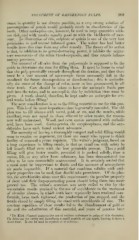Page 899 - My FlipBook
P. 899
TREATMENT OF GANGRENOUS PULPS. 909
crease in quantity is not always possible, as a very strong solution of
j^ermanganate of potash would probably result in discoloration of the
tooth. Other antiseptics can, however, be used in large quantities with-
out risk, and with results equally good as with the bichloride of mer-
cury. In illustration of this, sulphate of quinia is one of the very best
germicides in and around inflamed gums. The writer has had better
results from this than from any other remedy. The theory of its action
is that, in addition to its germ-destroying power, it inhibits the migra-
tory movements of the white blood-corpuscle, and thus retards inflam-
matory processes.
The removal of all odor from the pulp-canals is supposed to be the
guide to determine the time for filling them. It must be borne in mind
that the pulp practically extends throughout the dentine, and that there
must be a vast amount of microscopic tissue necessarily left in the
canaliculi for future decomposition or discoloration ; this is undoubt-
edly the cause of the change of color, more or less pronounced, in all
these teeth. Care should be taken to have the antiseptic fluids pass
well into the tubes, and to accomplish this by imbibition time must be
given. A tooth should, therefore, be kept under an antiseptic for sev-
eral weeks before filling.^
The next consideration is as to the filling material to use for this pur-
pose. This is of far more importance than is generally conceded. The old
plan was to fill always with metal, gold, or tin, and the results, while
excellent, were not equal to those effected by other modes, for reasons
now well understood. Wood, and even cotton saturated with carbolic
acid, have been used. Gutta-percha, the oxyphosphates, and the oxy-
chlorides have each found earnest advocates.
The necessity of having a thoroughly compact and solid filling would
seem to require no argument, yet there are many who appear to think
facility of removal a prime requisite. The writer's judgment, based on
a long experience in filling canals, is that no canal can with safety be
left loosely filled even with the best germicide present. That a gold
filling will give better results, provided it is packed solidly, than a
cotton, felt, or any other loose substance, has been demonstrated too
often to be now successfully controverted. It is certainly settled that
a canal must be impervious to fluids and the entrance of atmospheric
air made impossible. If a material that combines solidity with anti-
septic properties can be used, that should take precedence. Of the jilas-
tics, the oxychlorides alone meet this requirement ; the peculiar property
of these and their deep-penetrating power should bring them into more
general use. The writer's attention was early called to this by the
remarkable results attained by the use of oxychloride in the treatment
of alveolar abscess, in w'hich teeth have repeatedly been rendered com-
fortable, loose teeth tightened, the production of pus stopped, and the
fistula closed by simply filling the canal with oxychloride of zinc. The
constant repetition of these results led to the abandonment of gold or
tin and the substitution of this material, and years of practice have
' Dr. Kirk (Cosmon) suggests the use of sodium carbonate in pnlps of this eliaracter.
He dries out the cavity and introduces a small particle of this agent, leaving it there a
short time. It can be used in crvstals or in solution.


